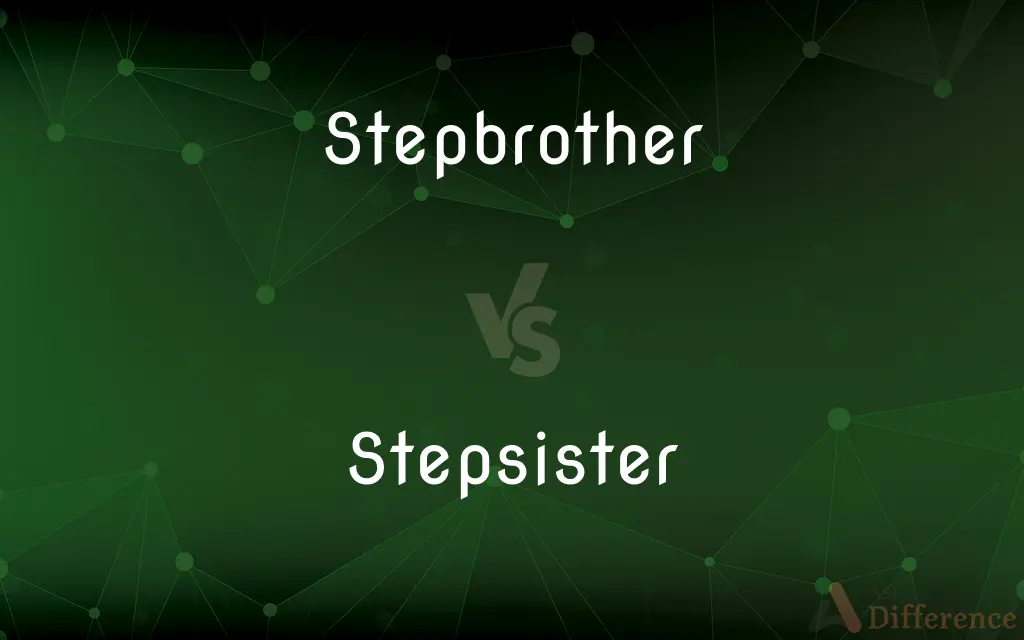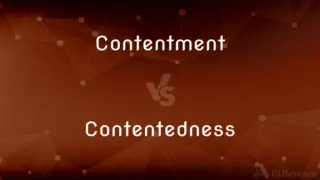Stepbrother vs. Stepsister — What's the Difference?
By Tayyaba Rehman & Urooj Arif — Updated on March 15, 2024
A stepbrother is a male sibling gained through the marriage of one's parent to someone with a son from a previous relationship, while a stepsister is the female equivalent.

Difference Between Stepbrother and Stepsister
Table of Contents
ADVERTISEMENT
Key Differences
A stepbrother is not related genetically but becomes part of the family when one of his parents marries someone with children from a previous relationship. This relationship does not depend on shared genetics but on the legal and social union of the parents. On the other hand, a stepsister is the female counterpart in such a blended family structure, sharing no biological parents with her stepsiblings but connected through the marriage of their parents.
Stepbrothers and stepsisters may come into one's life at any stage, depending on when their parent and the child's parent decide to marry. The timing of this event can significantly impact the nature of the relationship, with earlier blending often leading to closer sibling bonds. While stepbrothers are typically seen in contexts that involve activities or roles traditionally associated with males, stepsisters might share experiences or interests considered traditionally feminine, though these distinctions are increasingly seen as outdated.
The dynamics within a family containing stepbrothers and stepsisters can vary widely. Factors such as age differences, living arrangements, and the presence of any shared siblings (half-siblings) play a significant role in defining these relationships. Whereas stepbrothers might bond over shared activities or mutual interests, stepsisters might connect through shared experiences or familial roles, highlighting the diversity of sibling relationships in blended families.
Stories and media often explore the complexities of stepbrother and stepsister relationships, sometimes focusing on the challenges of blending families or the potential for strong, supportive bonds to form. These narratives can provide insights into the adjustments and accommodations families may make to foster harmony and understanding among step-siblings.
Legal and social recognition of stepbrothers and stepsisters varies by culture and jurisdiction, with some places offering rights or acknowledgments to stepsiblings similar to those of biological siblings. This recognition can affect matters such as inheritance, custody, and familial obligations, demonstrating the formal acknowledgment of the familial bond.
ADVERTISEMENT
Comparison Chart
Definition
A male sibling acquired when a parent marries someone with a son from a previous relationship.
A female sibling acquired when a parent marries someone with a daughter from a previous relationship.
Relationship Basis
Legal and social, not biological.
Legal and social, not biological.
Common Connections
Bond over shared activities or mutual interests traditionally associated with males.
Connect through experiences or roles often seen as traditionally feminine.
Family Dynamics
Influenced by factors like age, living arrangements, and shared siblings.
Influenced by similar factors, with potential variations in bonding and interactions.
Cultural Representation
Often explored in stories focusing on challenges and bonds in blended families.
Similarly portrayed, with emphasis on adjustment and relationship development.
Legal/Social Recognition
Varies by jurisdiction but can include certain rights and obligations.
Similarly varies, with potential implications for inheritance, custody, and more.
Compare with Definitions
Stepbrother
A male sibling gained through parents' remarriage.
My stepbrother and I bonded over our love for soccer.
Stepsister
Integrates into the family through marriage, not genetics.
Having a stepsister has doubled the fun at family gatherings.
Stepbrother
Relationship defined by parental marriage.
He became my stepbrother after our parents' wedding last year.
Stepsister
Bonds can form despite the lack of a biological link.
My stepsister and I are close, despite meeting just two years ago.
Stepbrother
Can share living spaces or familial experiences.
My stepbrother and I often collaborate on household chores.
Stepsister
May live together or apart, depending on family arrangements.
Though my stepsister lives with her mom, we hang out on weekends.
Stepbrother
Reflects the diverse forms of modern family units.
My stepbrother's arrival helped expand our family's horizons.
Stepsister
A female sibling gained through parents' remarriage.
My stepsister and I love to share fashion tips.
Stepbrother
Forms part of a blended family structure.
Since our parents got married, I've gained two stepbrothers.
Stepsister
Symbolizes the evolving nature of family connections.
My stepsister's presence has enriched my understanding of family.
Stepbrother
A son of one's stepparent by a previous union.
Stepsister
A daughter of one's stepparent by a previous union.
Stepbrother
The son of one's stepparent who is not the son of either of one's biological parents.
Stepsister
The daughter of one's stepparent who is not the daughter of either of one's parents.
Stepbrother
The stepson of one's parent who is not one's half-brother.
Stepsister
The stepdaughter of one's parent which is not one's half-sister.
Stepbrother
A brother by the marriage of one's father with the mother of another, or of one's mother with the father of another.
Stepsister
A daughter of one's stepfather or stepmother by a former marriage.
Stepbrother
A son of your stepparent by a former marriage
Stepsister
A sister who has only one parent in common with you
Common Curiosities
Are stepbrothers and stepsisters related by blood?
No, stepbrothers and stepsisters are not related by blood; their connection is based on the marriage of their parents.
What is a stepbrother?
A stepbrother is a male sibling that one acquires when one's parent marries someone with a son from another relationship.
Can stepbrothers and stepsisters have a close relationship?
Yes, stepbrothers and stepsisters can develop close and supportive relationships, depending on various factors like age and shared experiences.
What is a stepsister?
A stepsister is a female sibling that one gains when one's parent marries someone with a daughter from another relationship.
How do you become stepbrothers or stepsisters?
Stepbrothers and stepsisters are formed through the marriage of one's parent to another person who already has children.
Is it common to have stepbrothers and stepsisters?
Yes, with the prevalence of remarriage and blended families, having stepbrothers or stepsisters is increasingly common.
How are stepbrother and stepsister relationships portrayed in media?
They are often portrayed with a range of dynamics, from challenging adjustments to strong, supportive bonds, reflecting the complexities of blended family life.
Can stepsiblings share biological siblings?
Yes, if their shared parents have biological children together, those would be half-siblings to both the stepbrother and stepsister.
Do stepbrothers and stepsisters have legal rights to each other's property?
Legal rights vary by jurisdiction, but generally, stepsiblings do not have inherent rights to each other's property unless specified by law or in a will.
How do family dynamics change with stepbrothers and stepsisters?
Family dynamics can change significantly, requiring adjustments and accommodations to foster positive relationships among all family members.
Share Your Discovery

Previous Comparison
Contentment vs. Contentedness
Next Comparison
Squirrel vs. RatAuthor Spotlight
Written by
Tayyaba RehmanTayyaba Rehman is a distinguished writer, currently serving as a primary contributor to askdifference.com. As a researcher in semantics and etymology, Tayyaba's passion for the complexity of languages and their distinctions has found a perfect home on the platform. Tayyaba delves into the intricacies of language, distinguishing between commonly confused words and phrases, thereby providing clarity for readers worldwide.
Co-written by
Urooj ArifUrooj is a skilled content writer at Ask Difference, known for her exceptional ability to simplify complex topics into engaging and informative content. With a passion for research and a flair for clear, concise writing, she consistently delivers articles that resonate with our diverse audience.
















































